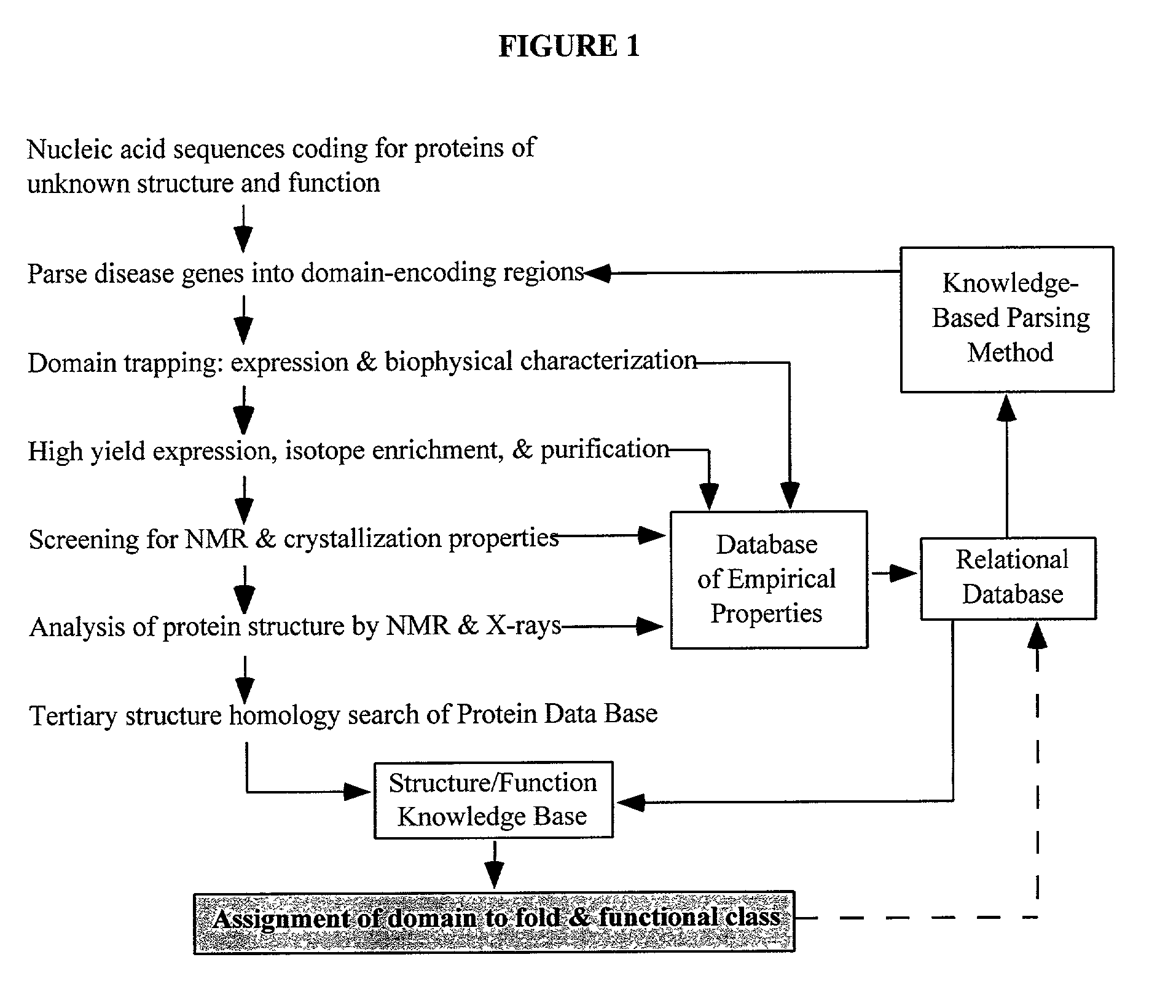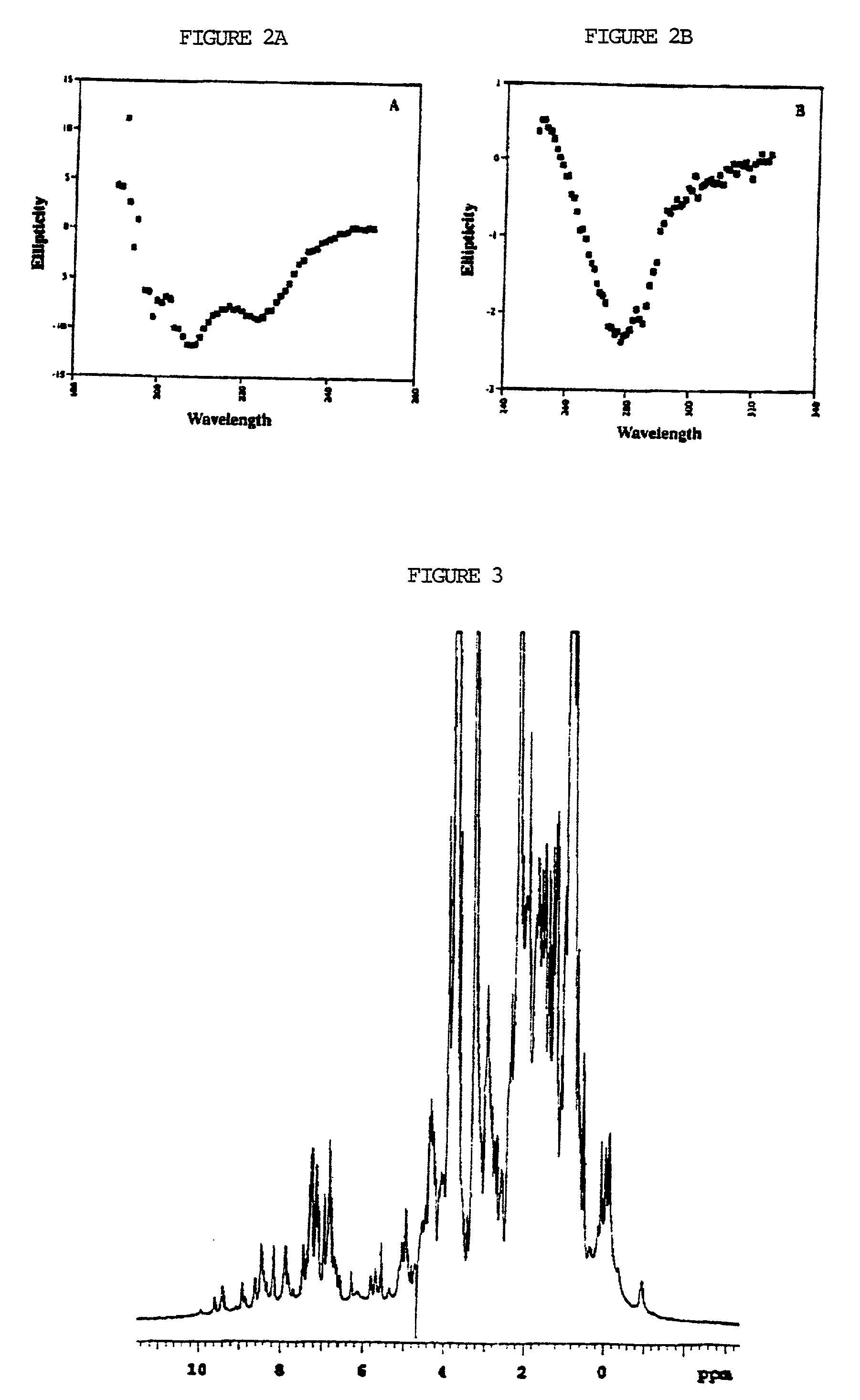Linking gene sequence to gene function by three dimesional (3D) protein structure determination
a technology of protein structure and three-dimensional separation, applied in the direction of peptides, instruments, molecular structures, etc., can solve the problem of the limiting component of the rate of this high-throughput "engine" being the number of nmr machines
- Summary
- Abstract
- Description
- Claims
- Application Information
AI Technical Summary
Problems solved by technology
Method used
Image
Examples
example 2
EXPRESSION AND PURIFICATION OF AN ISOLATED DOMAIN
[0146] The putative domain regions identified in Example 1 are sub-cloned into the secretion-based protein A fusion expression system and purified. Nilsson et al., Methods Enzymol. 185:144-161 (1990), herein incorporated by reference.
example 3
EXPRESSION AND PURIFICATION OF AN ISOLATED DOMAIN FOR NMR ANALYSIS
[0147] Protein Expression
[0148] E. coli strain RV308 is used as the bacterial expression host. Competent RV308 cells are transformed with pHAZY plasmid containing the NTD 2-3, Z domain insert. Cells are grown overnight at 37.degree. C. on LB agar plates supplemented with 100 g / ml ampicillin (Sigma). Fresh transformants are used to inoculate seed cultures in 2.times.TY media (16 g / l typtone, 10 g / l yeast extract, and 5 / g NaCl) supplemented with 100 .mu.g / ml ampicillin. Cultures are grown overnight at 30.degree. C. in 250 ml baffled flasks. A ratio of 1 to 25 is used to inoculate expression cultures. For 1 liter of MJ media expression culture (2.5 g / l .sup.15NH.sub.4 sulfate (>98% purity), 0.5 g / l sodium citrate, 100 mM potassium phosphate buffer, pH 6.6, supplemented with 5 g / l .sup.13C-glucose (>98% purity), 1 g / l magnesium sulfate, 70 mg / 1 thiamine, 1 ml of 1000.times.trace elements solution, 1 ml of 1000.times.vitam...
example 4 domain
TRAPPING:CHARACTERIZATION OF AN ISOLATED DOMAIN
[0154] Characterization of an isolated domain (NTD2-3) from the Alzheimer's amyloid precursor protein (APP) by circular dichroism measurements in the far UV shows an ellipticity minimum at 222 nm, indicative of ax-helical secondary structure (FIG. 2A). Of even greater significance, CD measurements at longer wavelengths reveal a clear signal in the aromatic region around 280 nm, consistent with the presence of Trp, Tyr, and Phe chromophores in an ordered environment such as would be expected in the hydrophobic core of a folded protein (FIG. 2B). A moderately concentrated solution (.about.100 .mu.M) of the isolated N-terminal domain is further characterized by one-dimensional .sup.1H-NMR. The isolated recombinant APP N-terminal domain exhibits high dispersion of the proton resonances, which is a signature of well-folded polypeptides (FIG. 3).
[0155] A time-course of amide hydrogen-deuterium exchange measurements is performed. From this, it...
PUM
| Property | Measurement | Unit |
|---|---|---|
| pH | aaaaa | aaaaa |
| temperature | aaaaa | aaaaa |
| time | aaaaa | aaaaa |
Abstract
Description
Claims
Application Information
 Login to View More
Login to View More - R&D
- Intellectual Property
- Life Sciences
- Materials
- Tech Scout
- Unparalleled Data Quality
- Higher Quality Content
- 60% Fewer Hallucinations
Browse by: Latest US Patents, China's latest patents, Technical Efficacy Thesaurus, Application Domain, Technology Topic, Popular Technical Reports.
© 2025 PatSnap. All rights reserved.Legal|Privacy policy|Modern Slavery Act Transparency Statement|Sitemap|About US| Contact US: help@patsnap.com



